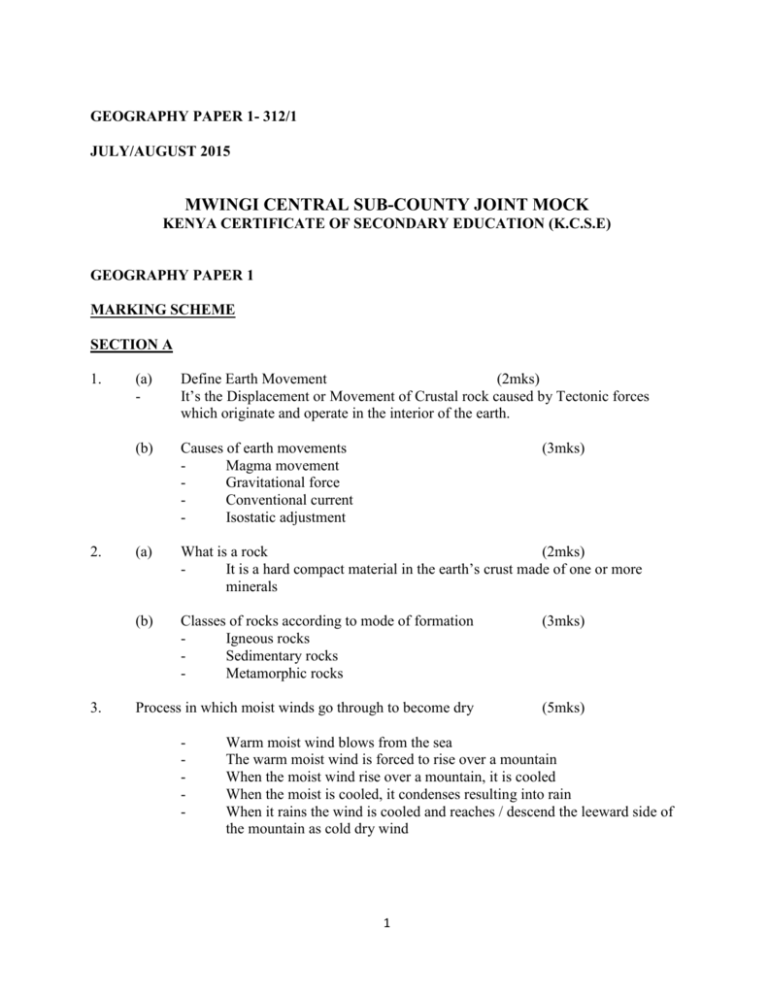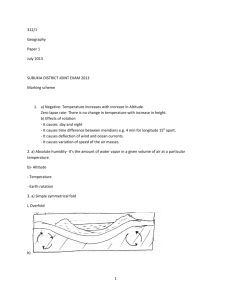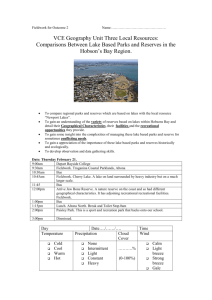mwingi central sub-county joint mock
advertisement

GEOGRAPHY PAPER 1- 312/1 JULY/AUGUST 2015 MWINGI CENTRAL SUB-COUNTY JOINT MOCK KENYA CERTIFICATE OF SECONDARY EDUCATION (K.C.S.E) GEOGRAPHY PAPER 1 MARKING SCHEME SECTION A 1. 2. 3. (a) - Define Earth Movement (2mks) It’s the Displacement or Movement of Crustal rock caused by Tectonic forces which originate and operate in the interior of the earth. (b) Causes of earth movements Magma movement Gravitational force Conventional current Isostatic adjustment (a) What is a rock (2mks) It is a hard compact material in the earth’s crust made of one or more minerals (b) Classes of rocks according to mode of formation Igneous rocks Sedimentary rocks Metamorphic rocks (3mks) Process in which moist winds go through to become dry (5mks) - (3mks) Warm moist wind blows from the sea The warm moist wind is forced to rise over a mountain When the moist wind rise over a mountain, it is cooled When the moist is cooled, it condenses resulting into rain When it rains the wind is cooled and reaches / descend the leeward side of the mountain as cold dry wind 1 4. 5. (a) Types of folds Simple symmetrical fold Assymetrical fold Overfold Isoclinal fold Recumbent fold Overthrust fold (Nappe: fold) Anticlinorum and synclinorium complex (2mks) (b) Name of fold mountains found in the following confirurents South America – Arides South Africa – Cape Ranges Europe - Alps (a) Types of Mass Wasting Rapid mass movement Slow mass wasting (b) Positive effects of weathering (3mks) Lead to soil formation Weathering give beautiful scenery which are tourist attraction centres Weathering produce construction materials e.g. sand, stones and blocks Weathered product dissolved in sea water provide nutrients to marine animals (2mks) SECTION B 6. (a) (i) (ii) (b) Distance 11km ± 0.5 = 2mks Area Full sq = 25 +2 sq = 20 = 10 2 = 35km2 = 2mks (i) Social service Education Administration Health services Judicial services Evidence Presence of schools Presence of DO’s offices and chief camps Presence of hospitals and dispensaries Court houses 3 x 2 = 6mks (ii) Drainage of the area covered by the map - There are permanent rivers - Most of the river tributaries drains their water to Ikoo River - Most the rivers flow from North West to South East 2 (c) (i) - There are presence of bore holes There are dams e.g. Kauma dam, Boni dam etc Most rivers form dentritic drainage pattern 4 x 1 = 4mks Natural vegetation Scattered trees Scrubs (ii) Bearing = 3 x 1 = 3mks 2260 ± 10 2 x 1 = 2mks (d)(i) Reasons for route map To know the direction To familiarize with the area of the study To estimate the distance To assist in making the time schedule To show distribution of features To avoid getting lost Estimate time likely to be taken 3 x 1 = 3mks (ii) 7. (a) Advantages of studying river through field work To enable student relate what they have learnt in classroom Students are able to count the number of tributaries Students are able to gauge the impact of river in the area Students are able to find the use of river 3 x 1 = 3mks (i) - Two types of faults Normal fault Reverse fault Tear/shear fault (2mks) (3 x 1 = 3mks) (ii) - (b) Occurrence of compressional forces: Starts in the upper mantle which is molten Coventional current in the mental exerts frictional drag with the same layers/crustal layers Crustal rocks moves toward one another – compressional force (3 x 1 = 3mks) Formation of Rift Valley by tensional forces Step 1 3 Step 2 Step 4 NB: Each step 2 mks (4 x 2 = 8mks) (c) Significance of faulting to human activities (i) Leads to formation of lakes e.g. Lake Naivasha – which provide water for domestic, industrial use and irrigation -Also we get fish from the lake 4 7. (c) - Formation of hot springs and geysers – production of geothermal in Olkaria - Keya Block mountains e.g. Ruwenzori receive high rainfall – Agriculture Features formed e.g. fault scarps attract tourist – foreign exchange Vertical fault across a river may form a water fall – suitable for dam construction – generation of hydro-electric power Disruption of communication line e.g. railways Subsidence of land which may lead to loss of life and property Faulty across a river may lead to disappearance of a river Any other relevant point (4 x 2) = 8mks (i) - Problem they likely faced during the study Adverse weather condition i.e. rainfall Difficult terrain to move on i.e. steep slopes Attach by wild animals i.e. sneaks (2 x 1 = 2mks) (ii) - Physical features they likely saw Escarpments Block mountains Lakes Hot springs and geysers - (d) (2 x 2 = 2mks) Artesian Basin (2mks) 8. (a) (i) Karst Scenery (2mks) These are features formed in an area with limestone rock. (ii) Diagram showing underground features found in Limestone area (5mks) 5 (iii) Factors leading to formation of Karst Scenery (6mks) - Presence of hard well jointed rock to allow permeability of water underground - Hot and humid climate with abundant rainfall - Water table should be far below the surface to allow water percolate down rocks (b) (i) (ii) - (c) It is the stratum in the earth surface in which one or more aquifer are enclosed above and below by an impermeable strata Condition necessary formation of an Artesian basins (6mks) Aquifer should be of the same permeable material Aquifer must be exposed in areas with sufficient precipitation Aquifer must lie in between two impermeable strata of rock to retain water The basin must dip toward a pegion where the land surface is lower than it’s exposed ends Importance of Artesian Basin Provide water for irrigation Provide water for domestic and industrial use Encourage settlement since it is a source of water 6 9. (i) (ii) (b) (c) (d) Describe how Lake Victoria was formed. Formed when the earth surface down warped and titled forming a hollow depression that was filled with water How Lake Victoria influence the climate of the surrounding areas - Heavy rainfall due to moisture from the lake - High temperature due to low altitude caused by the depression - Availability of water has attracted the industrial set up that pollute the environment (3 x 2) = 6mks Why some lakes in the rift valley have fresh water Presence of surface outlets through which excess salt deposits are drained away Some of the lakes have sub-terranean outlets which drain the salt from the lake beds Some have regular in flow of fresh water which dilutes the salts keeping the water fresh Some are situated in areas of low temperature thus low evaporation rates Some are situated in areas of high rainfall which keep water fresh 4 x 1 = 4mks Economic uses of Lakes Fishing Transport Irrigation Production of H.E.P Source of water for industrial and domestic use 5 x 1 = 5mks (i) (ii) (iii) 10. (a) (b) (i) Deforestation Rivers pouring water into lakes dry up as their sources are interfered Industrialization: Water matter/sewage is let to spill in lakes polluting the water Water weeds: It leads to depletion of fish breeding grounds and affect transportation Types of vegetation Natural vegetation Derived vegetation Cultivated vegetation (3mks) (i) A B C D Vegetation zones Savana grassland Woodland Mountain forest Bamboo forest (4 x 1 = 4mks) (3mks) (ii) Importance of vegetation in zone C - Purification of air in biosphere (6mks) 7 (3 x 1 = 3mks) - c. Roots and plants bind soil together and check rain intensity – control soil erosion Habitat for wildlife – attraction of tourist generating foreign exchange View material for industries e.g. pulp, paper Some plants used in manufacture of medicine Aesthetic value – makes land beautiful Water catchment area – source of rivers (3 x 2 = 6mks) (iii) What the government is doing to protect forest (6mks) - Reforestation programs - Legal action – law governing harvesting of trees - Employment of forest guards - Gazeting areas to become forest resource (i) Methods of data collection used Observation Photography Experimental Interviewing (3 x 1 = 3mks) (ii) Importance of a working schedule - Avoid time wasting - Ensure all areas covered - Get time estimate to be used - Enable them get all relevant equipment e.g. tools - Any other relevant point (3 x 1 = 3mks) 8









